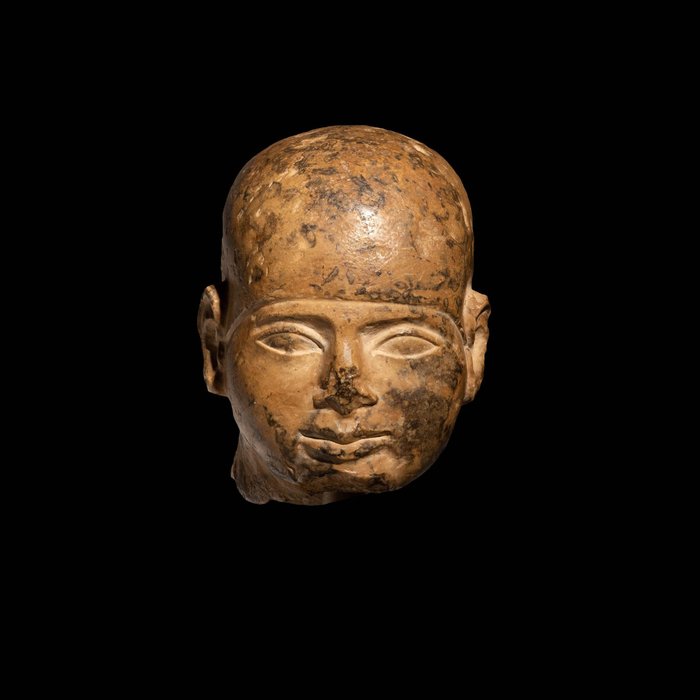编号 88181309

古埃及 硬化石灰石 卜塔神雕像。晚期,公元前 664 - 332 年。高 10.5 厘米。
编号 88181309

古埃及 硬化石灰石 卜塔神雕像。晚期,公元前 664 - 332 年。高 10.5 厘米。
Sculpture of the God Ptah.
Ancient Egypt, Late Period, 664 - 332 B.C.
MATERIAL: Hardened limestone.
DIMENSIONS: 10.5 cm height.
PROVENANCE: Private collection, Marquis Pierre d'Archanges (1886 - 1973), France.
CONDITION: Good state of preservation.
DESCRIPTION:
Head of a sculpture, carved from a block of stone in round bulk with a dorsal pillar, representing the Egyptian deity Ptah. With the face of an adult male, its only identification with the god is through the use of the smooth skullcap fitted to the head, used by the priests, characteristic of Ptah. The blow to the chin, following the break line of the neck, does not allow to keep the beard straight, another characteristic element of the god, but if the shape of the end of the chin indicates that it was sculpted.
It would be a complete image of the god, body wrapped by a shroud that would perfectly embrace the contours of the body, it would go from the feet to the neck, defining arms and only protruding hands. Placed on a plinth or rectangular base and by way of stability, a dorsal pillar from the base to half the height of the head. With his hands he would hold the scepter was, an ankh symbol and a djed pillar (figs. 1 and 2).
Although he is not one of the most famous gods, he is one of the most important in the Egyptian pantheon. His name could mean "The Creator", he was sovereign of all the gods having created the world through the word. He is known by other titles such as "Lord of Magic", "Lord of Darkness" and "Lord of Truth". He is originally from Memphis, capital of the Old Kingdom, and where from the New Kingdom he formed a triad with his wife Sekhmet and his son Nefertum. He was also known as a funerary god, because in pictorial images he appears with a green face, a sign of being a god of the Beyond, like Osiris.
One of the most important functions of Ptah is the patron of artisans, especially goldsmiths and sculptors. He was considered the inventor of the techniques and manual practices, and so was worshiped in the famous village of craftsmen of Deir el-Medina. The work of jewelry used to be done by dwarves, who were under the tutelage of the god Ptah and his sons, the Patheos.
BIBLIOGRAPHY:
- SILVERMAN, D. Searching for Ancient Egypt: Art, Architecture and Artefacts from the University of Pennsylvania Museum. Pennsylvania University Press. 1997. Fig. 3.
- WILKINSON H. R. The Complete Gods and Goddesses of Ancient Egypt. London. 2003.
PARALLELS:
Fig. 1 Figure of the god Ptah. New Empire, Dynasty XVIII, reign of Amenhotep III, 1390 - 1353 B.C. From Karnak. Limestone. 106 cm high. Egizio Museum, Turin (Italy).
Fig. 2 Figure of the god Ptah. New Empire, Dynasty XVIII, reign of Amenhotep III, 1390 - 1353 B.C. From Karnak. Granodiorite. 207 cm high. Egizio Museum, Turin (Italy).
Notes:
- The piece includes authenticity certificate.
- The piece includes Spanish Export License (Passport for European Union) - If the piece is destined outside the European Union a substitution of the export permit should be requested, can take between 1-2 weeks maximum.
- The seller guarantees that he acquired this piece according to all national and international laws related to the ownership of cultural property. Provenance statement seen by Catawiki.
#MasterpiecesW39
